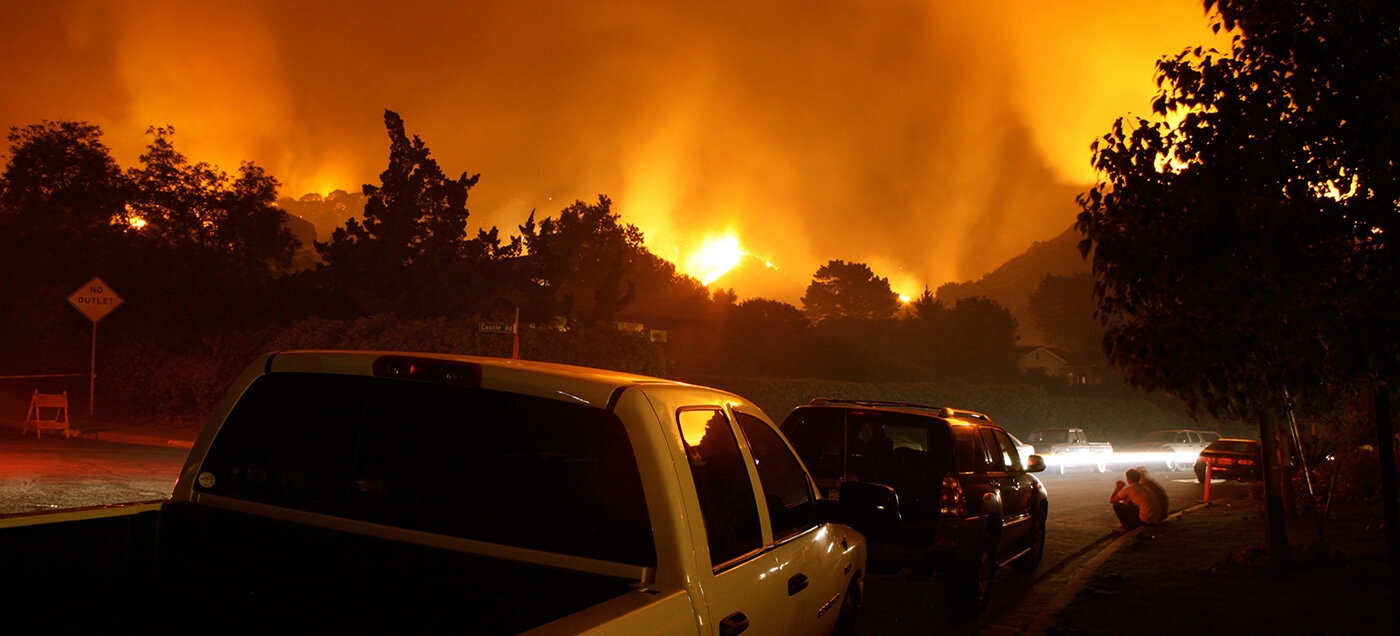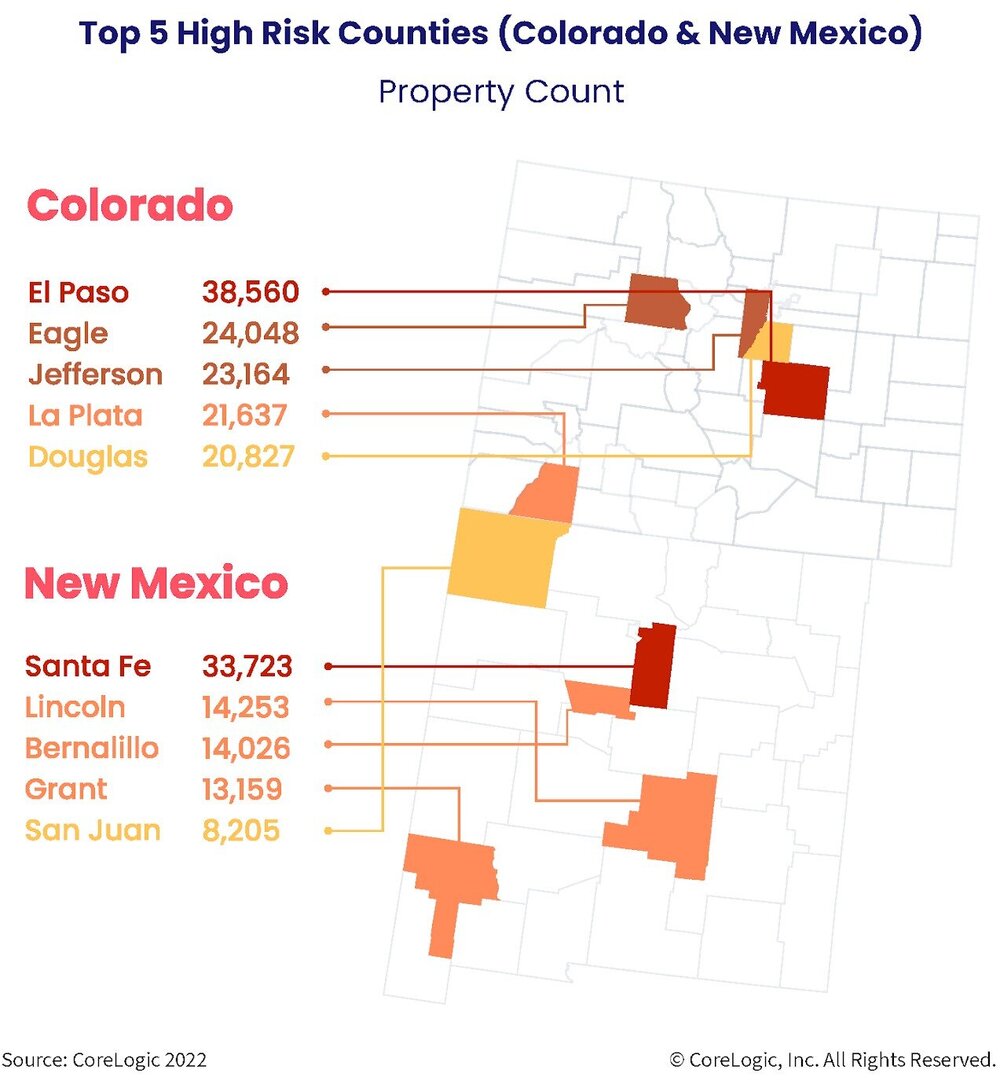Residential Real Estate News

Four Western States and Florida at Most Risk for Wildfire Property Damage in 2022
Residential News » Los Angeles Edition | By Michael Gerrity | September 12, 2022 8:04 AM ET
According to CoreLogic's newly released Wildfire Report for 2022, property owners in the Colorado Springs, CO and Santa Fe, NM metro areas run particularly high risks of property damage from wildfires.
Wildfires commonly affect the Western U.S., but climate change and the region's severe drought of recent years has only exacerbated the issue. Decreasing water levels in the Colorado River and Lake Mead, along with declines in snowpacks, have contributed to a longer wildfire season by an average of three months, resulting in a 1500% increase in burn areas. Over the past decade, CoreLogic data found that wildfires burned an average of 6.8 million acres per year, with that number topping 10 million acres in three of those years.
The 2022 CoreLogic Wildfire Report accompanies worrisome trends in wildfire-prone California, which is grappling not only with prolonged drought conditions but also with firefighter shortages. The Golden State employed about 25% fewer of these crucial first responders in the summer of 2022 than initially projected, amounting to 1,300 unfilled jobs.
Since California is the most populous state in the U.S. and also has the largest number of properties, it is once again the state where owners run the greatest risk of wildfire damage. Florida, Texas, Colorado and New Mexico round out the top five other riskiest housing markets for wildfire damages.
Two counties in Colorado and New Mexico have particularly concerning wildfire damage risks, given the number of homes that could be impacted. In Colorado's El Paso County - the state's most heavily populated and home to Colorado Springs - a wildfire could affect 39,000 homes,. New Mexico's Santa Fe County has an even greater percentage of risk given it is much smaller.
If a wildfire displaces large portions of a population at once, there are obvious societal ripple effects. Recovery times may take longer, fewer local workers might be available due to the disaster's impact on their own lives and housing options could be slim for outside workers helping to rebuild the damaged communities.
Since the global climate is shifting too quickly to rely on past wildfire activity and property damage as an accurate future barometer, CoreLogic has developed highly accurate risk models with the latest data and analysis from our team of experts. These models evaluate simulations of weather variations and help homeowners, communities, property businesses and insurers plan for risks and losses associated with climate change and the resulting wildfires.
"Consuming thousands of homes in the U.S. every year, wildfires present a real and present threat to our families and communities. Mitigating this risk will require commitment from homeowners, first responders, insurers and regulators. A first step in achieving the resilient communities we seek is to quantify what is at risk," said Tom Larsen, senior director of Insurance solutions at CoreLogic.
Climate change and the resulting uptick in wildfire activity is particularly relevant to home insurers in states like California, where new regulations will likely go into effect in the summer of 2023. These amended guidelines would require insurers to more accurately account for the mitigation of risks by factoring in a property's surroundings, attic and subfloor ventilation vulnerabilities and other circumstances that could affect its exposure to wildfire damage.
Sign Up Free | The WPJ Weekly Newsletter
Relevant real estate news.
Actionable market intelligence.
Right to your inbox every week.
Real Estate Listings Showcase
Related News Stories
Residential Real Estate Headlines
- U.S. New-Home Sales Surge in August as Mortgage Rates Ease
- Despite Increased Foreign Buyer Activity, Miami Residential Sales Dip 11 Percent in August
- California Home Sales Enjoy Modest Uptick as Mortgage Rates Ease
- U.S. Home-Flipping Profits Sink to Lowest Level Since 2008 Financial Crisis as Costs Climb
- Why the World's Rich Are Flocking to Europe in 2025
- Federal Reserve Delivers First Rate Cut of 2025 as Mortgage Relief Proves Limited
- Homebuilder Sentiment Holds Steady in U.S. as Rate-Cut Bets Lift Outlook
- U.S. Mortgage Rates Experience Sharpest Weekly Drop in Over a Year
- U.S. Foreclosures Rise for Sixth Straight Month as Affordability Pressures Mount
- Black U.S. Homeownership Rate Falls to Two-Year Low as Job Losses Mount
- Las Vegas Home Prices Flatten as Listings Surge, Sales Slow
- Cooling Miami Housing Market Sees 16 Percent Annual Sales Drop in July
- U.S. Mortgage Delinquencies Uptick in June Amid Regional Pressures
- California, Florida Top U.S. Housing Markets Most at Risk of Downturn
- 30-Year Mortgage Drops to 6.56 Percent in Late August, Lowest Since October 2024
- Investors Maintain Elevated Role in U.S. Housing Market Despite Slight Pullback
- Pending Home Sales Show Mixed Signals as U.S. Buyers Remain Cautious
- Canadian Home Sales Extend Recovery in July
- U.S. Home Sales Rise in July as Buyers Gain More Bargaining Power
- Zombie Foreclosures Edge Up Across U.S.
- 2.6 Million Homes at Wildfire Risk Across 14 Western States in 2025
- One in Five Americans Willing to Trade Personal Safety for Home Affordability
- U.S. Home Price Growth Slows as Affordability Pressures Mount in 2025
- U.S. Mortgage Rates Dip to Four Month Low in Early August
- U.S. Mortgage Applications Rise in Late July, Breaking Four-Week Slump
- Hong Kong's Housing Market Stuck in Stalemate as Bulls and Bears Face Off
- U.S. Condo Market Struggles in 2025
- U.S. Pending Home Sales Remain Sluggish in June
- Los Angeles Area Wildfires Destroyed Nearly $52 Billion in Homes Last January
- Greater Palm Beach Area Residential Sales Slip in June Amid Growing Inventory
- Economic Resilience Lifts U.S. Housing Outlook Going Forward
- New Home Sales Stagnate as Affordability Struggles Continue in America
- U.S. Housing Market Slips in June as Prices Hit New Highs
- Florida, California Continue to Reign Supreme as America's Ultraluxury Housing Markets
- Caribbean Housing Market Evolves into Global Second-Home Hotspot
- U.S. Home Sales See Highest June Cancellation Rate on Record
- Orlando Housing Market Cools in June as Listings Slide, Sales Slow
- Private Credit Surges in 2025 as Real Estate Developers Bypass Banks
- U.S. Condo Market Suffers Sharpest Price Drops in Over a Decade as Buyers Retreat
- Rising Taxes, Insurance Costs Undermine the Stability of U.S. Homeownership








